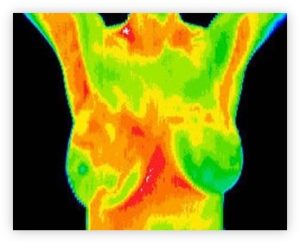
Dense Breasts is a hot topic these days, but it is also difficult to get accurate information about it. What exactly is Dense Breast Syndrome, or just “Dense Breasts?” What can you do if you have been diagnosed with this condition and, most importantly, what does it mean for your Breast Cancer risk? I’ll address all of these topics and then some in this article!
What is Dense Breasts Syndrome?
Breast tissue is comprised of fatty, glandular, and fibrous tissue, and the amount of each can vary depending on the woman. When the amount of fatty tissue in a woman’s breasts is significantly lower than fibrous and/or glandular tissue, a physician may give a diagnosis of “Dense Breasts,” or “Dense Breasts Syndrome (DBS).”
In fact, there are actually several “classifications” of breast density that you may already be aware of from your own doctor visits. Here is the breakdown, based on the Breast Imaging Reporting and Data System (BI-RADS) put out by the American College of Radiology. BI-RADS provides the criteria for all conventional physicians and radiologists when it comes to Dense Breasts:
“A” Classification indicates that a woman’s breasts are “almost entirely fatty tissue.”
“B” Classifications mean there are “scattered areas” of dense breast tissue.
“C” Classification indicates “heterogeneously dense breast tissue,” i.e. many areas contain glandular and fibrous tissue.
“D” Classification means that a woman has “extremely dense breast tissue.”
If you have been given a diagnosis of “Dense Breast Syndrome (DBS),” or simply “Dense Breasts,” it means that you have breasts that are classified as “C” or “D” on the BI-RADS breast density scale based on your mammography image.
The number of women who have dense breasts (classification C or D) is high among modern women. A joint study put together by the University of Vermont, the University of Wisconsin, UC Davis, and others found that a whopping 43% of all women aged 40-74 years have been given a dense breast diagnosis. The multi-year analysis estimated that approximately 25 million women “of common breast cancer screening ages” have the condition.
To break these numbers down a little more, the Mayo Clinic states that about 1 in 10 women will have “D” Classification breasts (extremely dense) while 4 in 10 women will have “mostly dense tissue.” Another 4 in 10 will have scattered areas of dense tissue in their breasts.
Studies also show that more younger women have dense breasts than women in their later years and that breast density tends to decline with age. Post-menopausal women are more likely to have more fatty tissue in their breasts than fibrous or glandular, as long as they have not had synthetic hormone replacement therapy. We will talk about that and other factors for DBS in the next section.
What Causes Dense Breasts and Why Do So Many Women Have It?
Conventional medicine states that Dense Breasts is an “inherited trait.” It also acknowledges, however, that certain epigenetic factors absolutely play a part in the expression of this trait. Remember that epigenetic factors for disease are environmental factors that can affect a person’s genetic expression. For example, poor lifestyle habits and diet are epigenetic factors that play a major role in the vast majority of cancer cases, according to a study put out by MD Anderson Medical Center.
To learn more about genetics and epigenetics, be sure to check out my latest Wellness Warrior podcast with Joe Cohen of Self-hacked. 
According to the Centers for Disease Control (CDC) and others, a major epigenetic factor for higher breast density is the use of Synthetic Hormone Replacement Therapy (SHRT).
One of the most significant investigations into the link between SHRT and DBS was a cohort study conducted in 2018 by half a dozen institutions and universities on three continents. The researchers analyzed data from 4,500 Danish participants and found a strong correlation between postmenopausal women using synthetic (non-bioidentical) hormone replacement therapy and breast density. They also found a strong correlation between SHRT and breast cancer. Of course, many studies have made that link throughout the years. For more information on the SHRT-Breast Cancer connection, be sure to check out this article.
According to the CDC, breast density is also higher in women with low body weight, women who are pregnant or breastfeeding, and younger women in general.
Dense Breasts and Breast Cancer
So, you have Dense Breasts and you want to know the facts, especially when it comes to your Breast Cancer risk. Rightly so!
Unfortunately, the link between Dense Breasts and breast cancer is not as cut and dry as other connections I have talked about in the past, such as xenoestrogens and Breast Cancer.
Putting mammography aside for a minute (we will get to that next), the link between actual breast density and the development of Breast Cancer remains inconclusive and studies continue to produce contradictory results.
One 2007 study found a connection but did not find a significant correlation between specific areas of breast tissue density and actual tumor development in that area. On the other hand, a 2000 report in the Journal of the National Cancer Institute determined that the risk of Breast Cancer in Women with Dense Breasts was as much as six times greater than those who did not have DBS. Then again, another study done in 2015 and presented at the annual meeting of the Radiological Society of North America (RSNA) found that “breast density may not be a strong independent factor for breast cancer risk.” All the while, the National Cancer Institute acknowledges on their website that raised risk factors for Breast Cancer amongst women with Dense Breasts do exist “separate from the effect of dense breasts on the ability to read a mammogram.”
Dense Breasts, Mammography, and “False Negatives”
Are you confused yet? You’re not the only one! There is one thing we do know, however.
“Breast Density Is The Strongest Predictor Of The Failure Of Mammography Screening To Detect Cancer.”
Breast areas come across as black or white using typical mammography technology. White areas mean denser tissue, which could be fibrous tissue or cancer. Today’s mammography machines have a “sensitivity” for dense breast tissue that is about 27%. Even the latest digital mammography equipment comes in with a sensitivity rating of only about 60 %.
As one doctor once said: “Trying to find a tumor with dense breasts on a mammogram is like trying to find a polar bear in a snow storm!
“Happygram” is an award-winning documentary that shines a light on this gross problem by highlighting women who have been the victims of “false negatives.” False negatives indicate when a woman is told that she does not have Breast Cancer based on a mammogram report when really she does. Many women are not even told that they have Dense Breasts in the first place and often these women find out they have cancer after it has advanced considerably. As one woman featured in “Happygram” explains:
“Every October, you see the billboards pop up. You see the messages on TV. You see the American Cancer Society and all of the people marching for Breast Cancer. But you don’t see anybody say, ‘Did you know that mammograms can miss up to 75% of all Breast Cancers if you have Dense Breasts?’ “
Choose Alternate Screening Options If You Have Dense Breasts!
If you have Dense Breasts Syndrome, then it is important that you do not rely solely on mammography to check for breast cancer. I always respect a woman’s right to make her own decisions when it comes to her own body. I also believe that those decisions should be informed ones. You can read about the risks associated with mammography HERE.
There are proven testing methods that will be able to detect anomalies that could be cancer if you have Dense Breasts. Here are a few that I recommend:
#1 Ultrasound
The women in the film “Happygram” were all victims of a medical system that is not being held accountable to the people that they are supposed to be serving. Other women, including many, highlighted in the film, have made it their mission to change that. In the early 2000s until her death a few years ago, Dr. Nancy M. Cappello made it her life’s work to ensure that women with Dense Breasts get the information and the support they need from the medical establishment. Through the organization she created, AreYouDense.org, she and others were able to pass legislation requiring clinics and hospitals to inform patients of a Dense Breast diagnosis and offer additional screening.
In many states where the law is in effect, insurance companies are required to cover additional ultrasound screenings for women with Dense Breasts. This is great news for patients but continues to be fought against by insurance companies.
Ultrasound uses sound waves to create an image and is often able to “see” past dense breast tissue. It is non-invasive, side-effect free and is now covered by most insurance depending on your state. There are currently 30 states in the US that operate under Dense Breast laws. These laws vary in scope state-to-state. To find out if Dense Breast legislation is in effect in your state, click HERE.

#2 Thermography
Thermography is an early detection tool that has proven to be very effective and monitoring physiological changes in breast tissue. Thermography, also called Digital Infrared Thermographic Imaging (DITI), reads the infrared heat being emitted from your body and is translated into an image. DITI can pick up “hot spots” that can indicate inflammation and other anomalies in breast tissue. This means that DITI can detect unhealthy changes in the breast tissues years before a mammogram can. Thermography is non-invasive, pain free and side-effect-free.
No tool is able to detect Breast Cancer 100% of the time. If you have Dense Breasts, thermography backed up with an ultrasound, is a reliable way to screen you breasts every year. Be sure to work with a qualified thermographer in your area.
Prevent Dense Breasts and Breast Cancer with the 7 Essentials System®
The best way to protect your breasts and prevent cancer is to put into place healthy diet and lifestyle habits that can ensure a cancer-free, vibrant life for years to come! In fact, gaining the knowledge and getting the support to live a healthy, cancer-free life is what the 7 Essentials System® is all about!
If you have Dense Breasts, be sure to be selective if you choose hormone replacement. Studies have shown it to raise the risk of reproductive system cancer as well as heart disease in women. Bioidentical Hormone Replacement Therapy may be an alternative to discuss with your integrative practitioner.
And if you are new to this site, keep reading! Get to know the 7 Essentials System®, take advantage of the 7-day free trial of my How To Create Vibrant Breast Health program, or reach out to our support team.

How about MRI?
Yes, an MRI sounds good
This is very educative study to know especially women but am grateful that I come across this platform nd am interested.